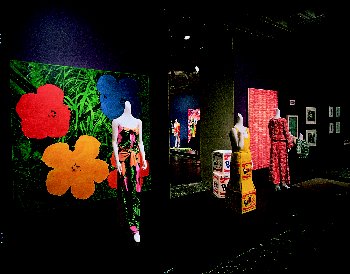
Home at Last
The Warhol Look
Glamour Style Fashion
June 4 to September 3, 2000
It debuted at the Whitney Museum
of American Art in New York, then traveled to Toronto, London, Marseilles,
Sidney, Perth, and Auckland. Now it’s home, after two years of showcasing
The Andy Warhol Museum as a center of contemporary art.
The Warhol Look features more than 500 works. It
has paintings, clothing, photographs, archival materials, illustrations,
reconstructed period window displays, film and video, and art by 60 other
designers and artists. Drawing primarily from the museum’s vast art and
archival collections, Mark Francis, past chief curator, and Margery King,
the museum’s associate curator, organized the show as high-style proof
of Warhol’s lifelong involvement with fashion.
"We called it The Warhol Look: Glamour Style Fashion
because we were thinking about the ways in which these subjects wove throughout
his entire career," says King. "We wanted to make it clear that he was
very interested in Hollywood glamour, and in tracking the style of his
time, and in being a trend-setter."
Director Thomas Sokolowski argues that Warhol’s success
in the fashion industry of New York was the key.
"The 1950s was an extremely energetic time for America
in big urban areas like New York City. The sexiest of all industries was
the world of advertising. It’s really crucial to understand that if Warhol
had not worked for the world of advertising--that also meant the world
of publishing magazines-- and the world of fashion, he never would have
become Andy Warhol , Pop artist. He learned from the great ad directors
and art directors—the people who gave spin to things—that if you could
create a myth around a person, an object or a thing, it would sell. He
learned that you had to simply, quickly, and indelibly grab the public
by the throat."
There were so many people involved in Warhol’s work as
a fashion-aware artist that you have to listen to the show’s Audio Guide
to experience the fun and flavor of it. Here, from the tape created by
The Warhol and the Art Gallery of Ontario, are a few cuts:
The 1965 image Warhol made of Elizabeth Taylor
was taken from a publicity photo of Taylor in the 1950s. Andy silk-screened
his image of Taylor in a firehouse he rented from the city. The colors
went every which way—the eye shadow is way above her eyes, the lips overflow
her actual lips. I told him that he if he wanted to get exact color placement,
he had to put pins down in the corner, and put the screen down within that.
Then he would get exact registration. Andy’s answer was," I kind of like
it this way." The moral I always gave everybody was that if he had listened
to me, he would not have been where he was."
---Nathan Gluck, Warhol’s first assistant
I was up at Andy’s loft, The Factory on 47th
Street, and Andy had just finished printing all his Brillo Boxes in preparation
for his Brillo show. We suddenly had the idea of printing some fabrics
by using the same screens, and I would make a dress out of it for the opening
and for the party. I thought this was going to be an architectural challenge—since
at that point we thought the dress should be like a box.
--Betsy Johnson, designer of clothes for the Velvet Underground
Silvery, hard mixed with soft, stretchy low slung
on the hips. I don’t think fashion will ever exceed how futuristically
wonderful it was in the time slot of ‘65 to ‘70. A lot of plastics, day-glows,
fluorescents, nylons…very Andy. But everybody was doing something very
Andy. We were all on that silver track, going a zillion miles a minute.
I don’t know how that skirt in the exhibit survived. It was a throw-away
clothing time. I kept nothing. I’d make my stuff, wear my stuff, trash
it, throw it out.
---Betsy Johnson
I’m afraid to look at my scars, so I always jump into
bed. I look like a Dior dress, or a Yves St.Laurent dress… a lot of stitches.
--Warhol,
when asked what he thought of his scars, after the operation that saved
his life in 1968.
Serendipity [Restaurant] in the 60s was very much of a
happening, and I decided to go into the fashion business. I had a wholesale
workroom on the second floor, and gave fashion shows twice a year. The
dresses you see in the show were both especially designed for Serendipity
by Andy Warhol. One is a long silk robe, tied at the waist empire style.
It compiles ice-cream cones, up and down, in bright, vivid colors. The
other is also on silk, with bright pretzel designs scattered all through
the dress. These are the first two pieces of clothing with Andy Warhol’s
images on them.
--Stephen Bruce, owner and founder of Serendipity
Three Restaurant at 225 East 60th S t.
|

